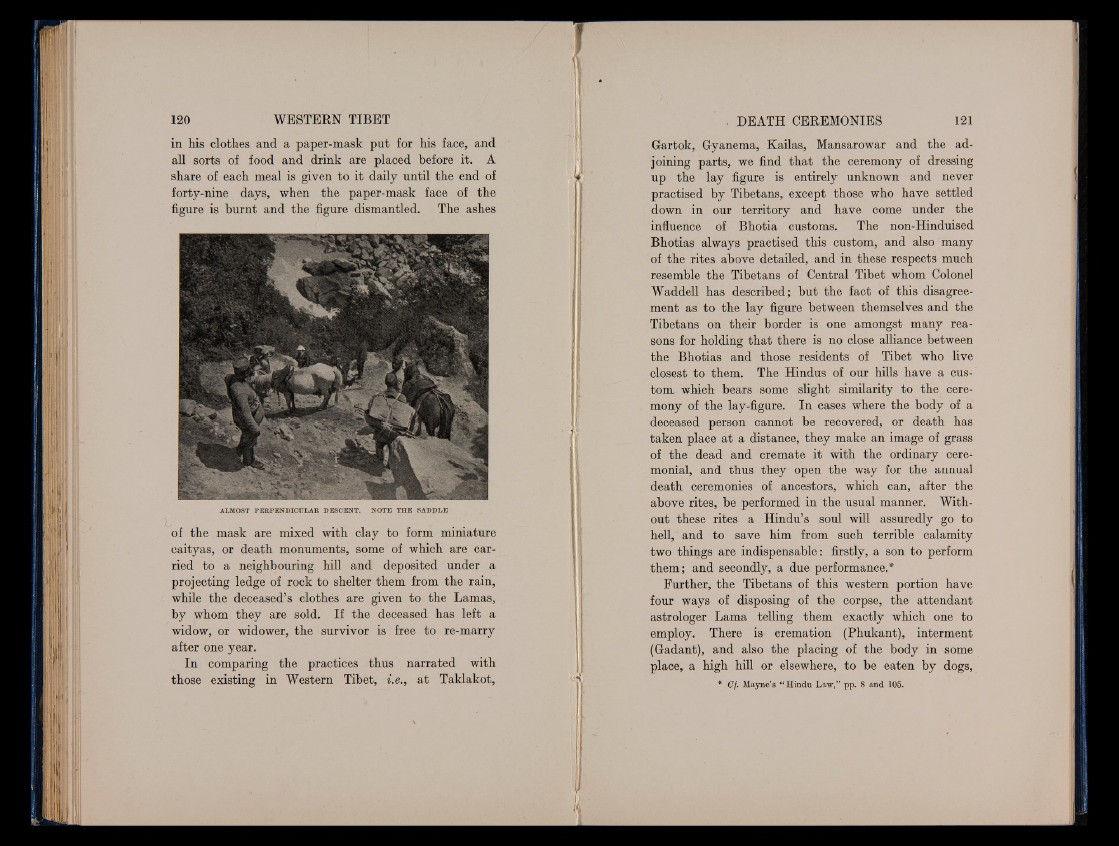
in his clothes and a paper-mask put for his face, and
all sorts of food and drink are placed before it. A
share of each meal is given to it daily until the end of
forty-nine days, when the paper-mask face of the
figure is burnt and the figure dismantled. The ashes
ALMOST PERPENDICULAR DESCENT. NOTE THE SADDLE
of the mask are mixed with clay to form miniature
caityas, or death monuments, some of which are carried
to a neighbouring hill and deposited under a
projecting ledge of rock to shelter them from the rain,
while the deceased’s clothes are given to the Lamas,
by whom they are sold. If the deceased has left a
widow, or widower, the survivor is free to re-marry
after one year.
In comparing the practices thus narrated with
those existing in Western Tibet, i.e., at Taklakot,
Gartok, Gyanema, Kailas, Mansarowar and the adjoining
parts, we find that the ceremony of dressing
up the lay figure is entirely unknown and never
practised by Tibetans, except those who have settled
down in our territory and have come under the
influence of Bhotia customs. The non-Hinduised
Bhotias always practised this custom, and also many
of the rites above detailed, and in these respects much
resemble the Tibetans of Central Tibet whom Colonel
Waddell has described; but the fact of this disagreement
as to the lay figure between themselves and the
Tibetans on their border is one amongst many reasons
for holding that there is no close alliance between
the Bhotias and those residents of Tibet who live
closest to them. The Hindus of our hills have a custom
which bears some slight similarity to the ceremony
of the lay-figure. In cases where the body of a
deceased person cannot be recovered, or death has
taken place at a distance, they make an image of grass
of the dead and cremate it with the ordinary ceremonial,
and thus they open the way for the annual
death ceremonies of ancestors, which can, after the
above rites, be performed in the usual manner. Without
these rites a Hindu’s soul will assuredly go to
hell, and to save him from such terrible calamity
two things are indispensable: firstly, a son to perform
them; and secondly, a due performance,*
Further, the Tibetans of this western portion have
four ways of disposing of the corpse, the attendant
astrologer Lama telling them exactly which one to
employ. There is cremation (Phukant), interment
(Gradant), and also the placing of the body in some
place, a high hill or elsewhere, to be eaten by dogs,
* Of. Mayne’s “ Hindu Law,” pp. 8 and 105.